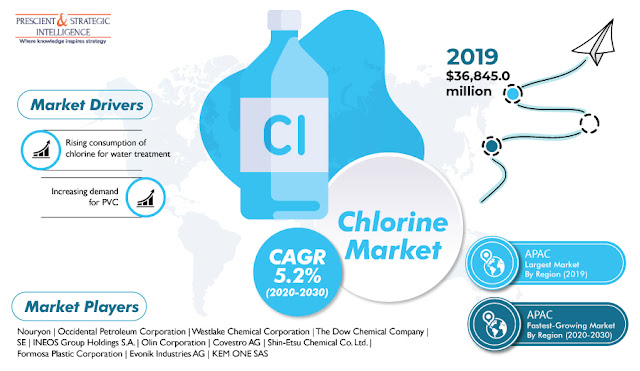
How Is High Volume PVC Demand Propelling Chlorine Production?
Chlorine is extensively used in the chlorination process required for the manufacturing of polyvinyl chloride (PVC), due to the enhanced thermal stability and higher melt viscosity offered by this gas during the production process. Huge quantities of PVC are used in windshield system components in the automotive industry, non-breakable components in the medical sector, and piping and siding applications in the building and construction industry. Thus, the rising usage of PVC in these application areas will augment the consumption of chlorine in the foreseeable future.
Additionally, the spurring demand for treated water is expected to drive the chlorine market at a CAGR of 5.2% during the forecast period (2020–2030). The market stood at $36,845.0 million in 2019, and it is projected to reach $63,121.6 million by 2030. Developing countries, such as Brazil, Thailand, and India, are increasingly focusing on raising public awareness regarding the harmful effects of consuming contaminated water and its role in amplifying the cases of typhoid, cholera, Hepatitis A, and Hepatitis E. As chlorine can terminate bacteria and other pathogens, it is being increasingly used in water treatment plants.
According to P&S Intelligence, Asia-Pacific (APAC) consumed the highest volume of chlorine in the past and it is expected to continue maintaining this trend in the foreseeable future as well. This can be ascribed to the escalating need for the chemical in China, Thailand, and India for manufacturing EDC/PVC. These countries are recording high volume production of EDC/PVC, due to its spurring requirement in insulation, door sidings, shingles, roofing, and flooring applications. Moreover, the growing public awareness regarding water-borne diseases will propel the usage of chlorine for water treatment in APAC in the coming years.
Moreover, the APAC chlorine market is expected to demonstrate the fastest growth during the forecast period, owing to the high demand for chlorine in the paper and pulp industry. The chemical imparts a white appearance to paper by removing lignin, a wood fiber element that offers a yellow appearance to paper under sunlight. The expansion of the paper and pulp sector in the region will, therefore, facilitate the market growth in APAC in the forecast years.
Thus, the soaring PVC need and the escalating public awareness regarding water-borne diseases will supplement the production of chlorine in the foreseeable future.
Source: www.psmarketresearch.com
Comments